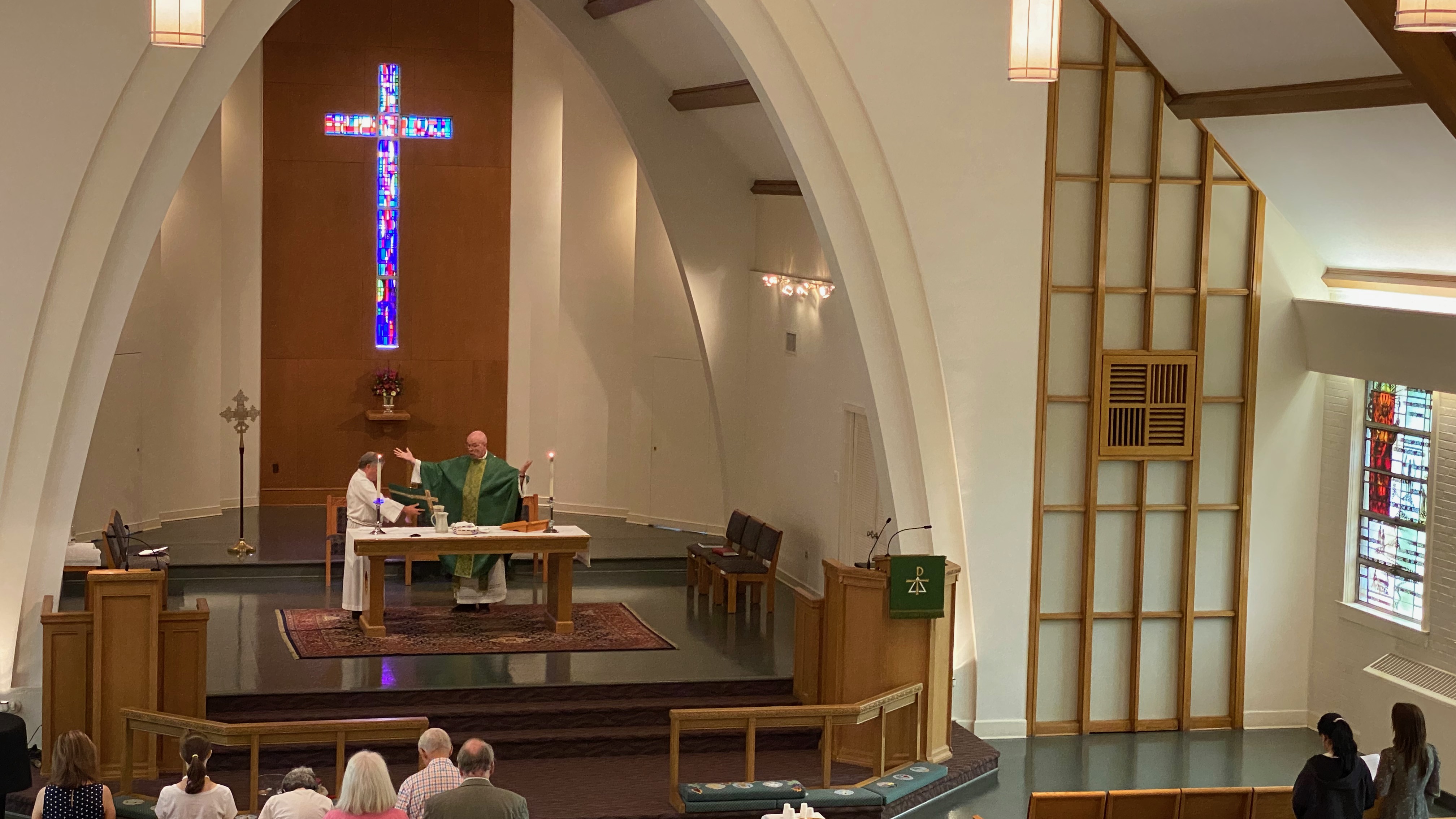During March, Women’s History Month, we are celebrating each week the contribution women have made to our worship either in our hymns, anthems, preludes or postludes, through musical compositions and/or texts rooted in this history and culture.
For this celebration of the Three Days and Easter Sunday our list includes the texts, “Cross of Glory” by Delores Dufner, and “There Is a Green Hill” by Cecil Frances Alexander and music by Evelyn Larter.
Hymn of the Day: Good Christian Friends, Rejoice and Sing, ELW 385
Text: Cyril A. Alington (1872-1955)
Tune: GELOBT SEI GOTT, Melchior Vulpius (c.1570-1615)
While Headmaster of Eton College, Cyril A. Alington wrote this text for Melchior Vulpius's tune GELOBT SEI GOTT. The hymn was published in Songs of Praise (1931). Stanley L. Osborn has written of Alington's stanzas, “They vibrate with excitement, they utter the encouragement of victory, and they stir the heart to praise and thanksgiving" (If Such Holy Song, 469). This text should not be mistaken for its Christmas counterpart "Good Christian Friends, Rejoice" (355); both texts originally began, "Good Christian men, rejoice."
A strong text for Easter, "Good Christian Friends" rings in the victory of Christ's resurrections so that "all the world" will know the news. Each stanza encourages us to tell the good news and praise the "Lord of life," and ends with an exciting three-fold "alleluia."
Educated at Trinity College, Oxford, England, Cyril A. Alington was ordained a priest in the Church of England in 1901. He had a teaching career that included being headmaster at Shrewsbury School and Eton College. He was dean of Durham from 1933-1951 as well as chaplain to the king of England. His writings include literary works and Christianity in England, Good News (1945). Many of his hymns appeared in various twentieth-century editions of the famous British hymnal, Hymns Ancient and Modern.
Born into a poor family named Fuchs, Melchior Vulpius had only limited educational opportunities and did not attend the university. He taught Latin in the school in Schleusingen, where he Latinized his surname, and from 1596 until his death served as a Lutheran cantor and teacher in Weimar. A distinguished composer, Vulpius wrote a St. Matthew Passion (1613), nearly two hundred motets in German and Latin, and over four hundred hymn tunes, many of which became popular in Lutheran churches, and some of which introduced the lively Italian balletto rhythms into the German hymn tunes. His music was published in Cantiones Sacrae (1602, 1604), Kirchengesangund Geistliche Lieder (1604, enlarged as Ein schon geistlich Gesanglmch, 1609), and posthumously in Cantionale Sacrum (1646).
Offertory Anthem: “Christ Jesus Lay in Death’s Strong Bands” Ryan Kelly
Martin Luther’s celebrated Easter hymn, “Christ Jesus Lay in Death’s Strong Bands,” receives an exuberant setting by Ryan Kelly for mixed voices and tambourine. An incorporation of the historic "Victimae paschali laudes" chant captures the mystery of Christ’s passion in contrast with spirited “alleluias” that respond to his victorious resurrection.
Opening Voluntary: “Easter Hymn” Phillip Moore (1943)
EASTER HYMN originally appeared in the John Walsh collection Lyra Davidica (1708) as a rather florid tune. Tempered to its present version by John Arnold in his Compleat Psalmodist (1749), EASTER HYMN is now one of the best and most joyous Easter tunes.
Philip Moore is a British composer who has written extensively for choirs and vocal ensembles. He has composed a wide range of sacred and secular music, including several large-scale works for choir and orchestra. Moore studied composition at the Royal Academy of Music in London under the tutelage of Alan Bush, and later at King's College, Cambridge. He served as the Master of Music at York Minster from 1983 to 2008, where he oversaw the music program and composed music for the choir. He has also held teaching positions at several institutions, including the Royal Academy of Music and the University of York. In 2019 he was commissioned to write the new carol for the annual service of Nine Lessons and Carols, broadcast from King’s College, Cambridge.
Moore's music is marked by its lush harmonies and rich textures, and often draws inspiration from poetry and literature. His works have been performed by leading choirs and orchestras around the world, and he has received numerous commissions and awards for his compositions.
Closing Voluntary: “Final” (from Symphony for Organ, #1), op. 14, Louis Vierne
Composed over 1898 - 1899, Vierne's Symphony in D minor for organ is his first major work and an ambitious throw at continuing the lineage of large-scale serious works for organ advanced by his mentors : Franck (in his Grande Pièce symphonique), and Widor, in his brilliant series of ten symphonies. This powerful, bravura Final of virile assertiveness became vastly popular -- Vierne referred to it as "my Marseillaise" and arranged it for organ and orchestra in 1926. The symphony as a whole announced the startling emergence of a major compositional voice and set the pattern for the five organ symphonies to follow -- a suite-like succession of movements in which confessional moments of disconcerting intimacy are juxtaposed with manifestations of eerie fantasy and virtuoso movements of tremendous power.
Good Friday Anthems
“The Mild Mother” Robert Convery (1954)
This anonymous text is a reflection on the anguish felt by Mary at the crucifixion, her sorrow and grief emulated by the music.
Robert Convery is among the handful of composers today writing effectively for the voice. His music is expressed in a distinctly personal tone of lyricism, rhythmic vitality, a keen harmonic sense, and transparent textures. He holds degrees from The Curtis Institute of Music, Westminster Choir College and The Juilliard School where he received his doctorate. His teachers have been Ned Rorem, David Diamond, Richard Hundley, Gian Carlo Menotti, and Vincent Persichetti.
Jesus Christ’s mild mother stood,
and beheld her son against the cross,
that He was nailed on.
The Son hung, the mother stood,
and beheld her child’s blood,
how it of His wounds ran.
“There Is a Green Hill” Evelyn Larter (1953)
Many thanks to Carole Smith for her beautiful interpretation of the flute obbligato.
This expressive anthem combines Cecil Alexander's Lenten hymn with the haunting English folk melody The Turtle Dove. This lyrical music renders a portrait of Calvary's hill that allows the listener to deeply ponder the agony of Christ's suffering. The culminating verse on the text "O Jesus, dearly have You loved and we must love You, too" is rich with meaningful expression.
Cecil Frances Alexander (1818-95), an Anglo-Irish hymn writer and poet, is the composer of this extremely popular hymn, There Is a Green Hill Far Away. Amongst other works, she wrote “All Things Bright and Beautiful” and the Christmas carol “Once in Royal David’s City”.
It draws its inspiration from the Apostles Creed especially the line, ‘Suffered under Pontius Pilate, was crucified, dead, and buried”. It is believed to have been written at the bedside of a sick young person. The writer gives substance and answer to those who inquire why Jesus died. She talks about God’s forgiveness. She speaks of how man can reclaim his original close relationship with God and suggests the only possible response is the total giving of loving self. The event was for us.
Evelyn Larter was born in Glasgow, Scotland, and studied at the Royal Scottish Academy of Music. She won the prestigious Governor’s Recital Prize for piano, and graduated with honors in concert piano and music education. She performed with the Highlands Sinfonia, and on Scottish television. Since moving to the United States with her husband and family in 1988, Evelyn has been active in the Philadelphia area, collaborating with many well-known soloists and ensembles.
There is a green hill far away, outside a city wall,
where our dear Lord was crucified who died to save us all.
We may not know, we cannot tell, what pains he had to bear,
but we believe it was for us he hung and suffered there
He died that we might be forgiven, he died to make us good,
that we might go at last to heaven, saved by his precious blood.
O dearly, dearly have you loved! And we must love you too,
and trust in your redeeming blood, and gladly follow you.
“Faithful Cross” Thomas Pavlechko
Thomas Pavlechko's compositions are always engaging and innovative, including this rich and expressive setting of the text “Cross of Glory” by Delores Dufner (1939).
Delores Dufner is a member of St. Benedict’s Monastery in St. Joseph, Minnesota, with Master's Degrees in Liturgical Music and Liturgical Studies. Delores is a writer of liturgical, scripturally based hymn and song texts which have a broad ecumenical appeal and are contracted or licensed by 34 publishers in the United States, Canada, Great Britain, Australia, and China. She has received more than 50 commissions to write texts for special occasions or needs and has published over 200 hymns, many of which have several different musical settings and appear in several publications.
Delores, the middle child of five, was born and raised on a farm in the Red River Valley of North Dakota. She attended a one-room country school in which she learned to read music and play the tonette, later studying piano and organ.
Before entering the monastery Delores was a school music teacher, private piano and organ instructor, and parish organist/choir director for twelve years.
Faithful cross, O tree of beauty, tree of Eden, tree divine!
Not a grove on earth can show us leaf and flower and fruit so fine.
Bearer, of our Savior’s body, tree of life, salvation’s sign!
Cross of pain, transformed to gladness, ever green and sheltering tree,
Symbol once of shame and bondage, now the sign that we are free!
Cross of splendor, cross of glory, cross of love’s great victory!
Christians, chant your grateful praises for the tree of triumph won, proof of overflowing mercy and redemption in the Son. To the cross of Christ give glory while the endless ages run!
“Paschal Lamb, Who Suffered for Us” Carl Schalk (1929-2021)
Musician, composer, and professor of music emeritus, Dr. Carl F. Schalk taught various music classes at his alma mater, Concordia University Chicago, for more than four decades. During his years as a professor, Dr. Schalk joyfully served as a mentor to future generations of church musicians and encouraged his students to remain true to the doctrine set forth by the Scriptures. Barry L. Bobb, director of the Center for Church Music at Concordia University Chicago, said these words about Dr. Schalk: “He has bequeathed to this generation and those to come an extraordinary model, one which will serve well all those who aspire to a life of significant service in the Church.”
Paschal Lamb who suggested for us, Sheepgate guarding all your sheep,
Let us hear your voice which summons Each of us, God’s will to keep.
Dead to sing through your great mercy, By your wounds we are made whole;
You have gathered us from straying, Safe may pass from death to life.
Guide and guard us through our sufferings, Let us hear you call our name,
Knowing you as our Messiah Who, for us, bore cross and shame.
In your victory make us sharers; Lead us new through sin and strife
That we all who share one Baptism Safe may pass from death to life.






